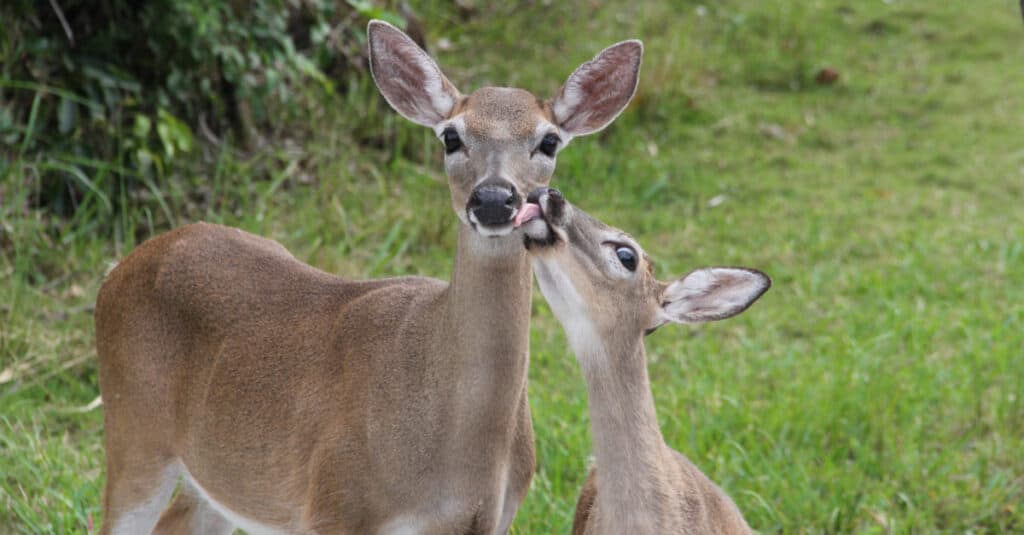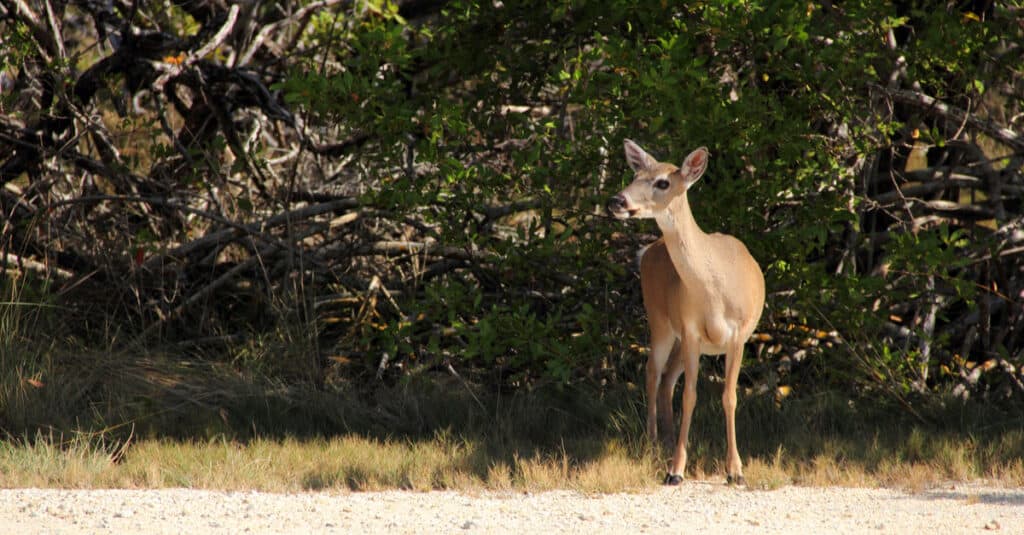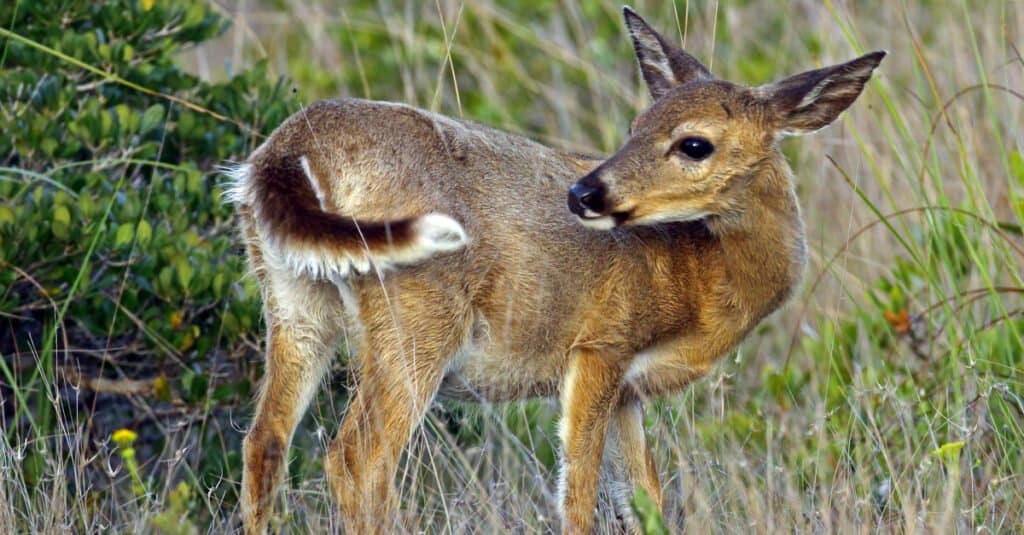Did you know that Key deer are the smallest white-tailed deer subspecies? They’re tiny, adorable, beautiful deer that, unfortunately, have a dramatic history of being hunted and poached by people and even harassed and killed by dogs. There are currently only several hundred deer living in the Florida Keys. However, people are working hard to reduce Key deer killings and deaths. Let’s find out more!
What Are Key Deer?

Key deer are the smallest extant deer in North America.
©Arend Trent/Shutterstock.com
Key deer are scientifically called Odocoileus virginianus clavium. They are a white-tailed deer subspecies and the smallest extant deer in North America. The Key deer population lives only in the Florida Keys.
Key deer are smaller than white-tailed deer, with males slightly larger than females. Male Key deer are roughly 30 inches tall at the shoulders and weigh, on average, 55 – 75 pounds. Female deer, however, reach approximately 26 inches in height and weigh between 44 and 64 pounds.
Male deer have antlers that grow by June and are shed between February and March. Both male and female Key deer are reddish-brown to gray-brown.
This deer species likes being around people and is often spotted around people’s houses and yards. Key deer live between 7 and 9 years.
These deer live in hardwood hammocks, mangroves, freshwater wetlands, and pine rocklands. In the past, they inhabited all of the lower Florida Keys. Nowadays, however, they can only be found from Sugarloaf Key to Bahia Honda Key. In their natural environment, Key deer primarily eat mangroves and thatch palm berries.
How Did Deer Get to the Florida Keys?
Key deer reached the Florida Keys during the Wisconsin glaciation. It is the most recent glacial period of the North American ice sheet complex. They used a land bridge to reach the Florida Keys.
How Many Key Deer Are Left in Florida?
There are currently around 700-800 Key deer individuals in the Florida Keys. However, this number is pretty encouraging compared to the 1950s and earlier periods! That’s because there were only 25 Key deer left in 1955. While the population has somehow stabilized in recent years, this deer species is still listed as endangered.
Key Deer Conservation Status

Key deer are currently listed as endangered.
©William Silver/Shutterstock.com
Key deer are currently listed as endangered. They have historically served as a food source for native tribes, early settlers, and passing sailors. Although it was illegal to hunt them by the end of the 1930s, they almost went extinct by the 1950s due to habitat destruction and poaching. In 1957, the National Wildlife Refuge established the National Key Deer Refuge to preserve the Key deer population.
In 2016, 135 Key deer were killed by the screwworm infestation. The screw worm, or fly larva, entered a deer’s open wound and ate the flesh from within. Thus, many deer were euthanized. By April 2017, the infestation was eradicated, and by August 2019, the United States Fish and Wildlife Service stated that the Key deer population was recovering.
Key Deer Conservation Efforts
The National Key Deer Refuge is located in the lower Florida Keys and has roughly 9,200 acres of land. It was established in 1957 to protect the Key deer population and other wildlife resources. The refuge hosts 23 threatened and endangered plant and animal species. You can visit this refuge to see these tiny, adorable creatures called Key deer! There’s a visitor’s center where you can get a map of the refuge and ask anything you’d like to know about the Florida Key deer population.
Key Deer Protection Alliance is a non-profit organization founded in 1989 that is working towards saving Key deer from extinction. The organization’s president is Alicia Putney, and the vice president is Elaine Sweet Mason. The organization played a great role in reducing speeding on U.S. Highway 1 and improving county animal control services. The KDPA organization welcomes new members willing to help preserve the beautiful key deer population!
A study on “Survival, Mortality, and Life Expectancy of Florida Key Deer” showed that more than half of deer deaths were linked to deer-motor vehicle collisions, half of which occurred on U.S. Highway 1. Since the 1990s, the United States Fish and Wildlife Service, the Florida Department of Transportation, and residents have worked together to reduce deer-motor vehicle collisions by minimizing the allowed speed, establishing no-passing zones, and increasing law enforcement surveillance.
How Did People Negatively Impact the Key Deer Population?

It is illegal to feed Key deer because they lose their fear of humans and may, in turn, wander into dangerous places.
©iStock.com/photographybyJHWilliams
Did you know that people are considered the biggest danger to the Key deer population? Since Key deer are beautiful social creatures, many people regarded (and still do) their friendliness as an invitation to feed them. This is, however, illegal because it can have disastrous consequences. Why? Because this way, deer lose their fear of humans and return to looking for (or getting) food and are more vulnerable to poaching, being hit by cars, attacked by dogs, or getting entangled in fences. Moreover, this may also cause them to gather in groups rather than spread across their natural habitat. In this case, if one deer gets sick, it will rapidly spread the disease to the other deer, thus endangering their overall population.
Other Endangered Deer Species
Pere David’s deer history is almost as curious as the Key deer story! They almost went extinct in the 19th century. However, there’s much more to their history than just this. In the 19th century, when their population registered a drastic drop, several deer were taken to France and German zoos, where they bred successfully. However, Herbrand Russel, the 11th Duke of Bedford, contributed the most to Pere David’s deer population. He took a few deer from the Berlin zoos and built up a large herd on his estate. His great-grandson donated several dozen individuals to be reintroduced to the wild. In 2020, China hosted almost 3,000 deer in the wild and another 7,380 in nature reserves.
Up Next:
- How and Where Do Deer Sleep? Patterns and Habitats
- Deer Season In Florida: Everything You Need To Know To Be Prepared
The photo featured at the top of this post is © iStock.com/SloMoe
Sources
- U.S. Fish & Wildlife Service, Available here: https://www.fws.gov/refuge/national-key-deer/about-us
- Visit Florida, Available here: https://www.visitflorida.com/travel-ideas/articles/florida-keys-how-to-see-local-wildlife/
- Florida Keys, Available here: https://floridakeys.com/lower-keys/key-deer/
- The National Wildlife Federation, Available here: https://www.nwf.org/Educational-Resources/Wildlife-Guide/Mammals/Key-Deer
Thank you for reading! Have some feedback for us? Contact the AZ Animals editorial team.






